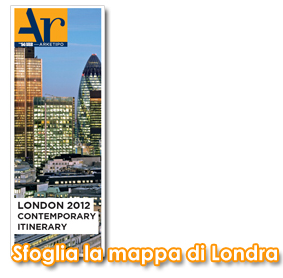Un recinto di muri massicci di colore rosso sovrastato da un'aerea copertura, dove poche e misurate aperture fanno intravedere la città; all'interno si intrecciano spazi aperti, ambienti interni, patii e terrazze. Così si presenta il nuovo centro per accogliere i malati di cancro voluto da Maggie Keswick Jencks. Il Centro Maggie a Londra è un piccolo edificio a sostegno dei malati di cancro e delle loro famiglie progettato dagli architetti Rogers Stirk Harbour + Partners e inaugurato nel 2008. Il centro fa parte di una serie di strutture distribuite sul territorio della Gran Bretagna volute dall'architetto Maggie Keswick Jencks che, ammalatasi di cancro, si rifiutò di lasciare la propria casa per seguire le necessarie cure in ospedali freddi e asettici: "non luoghi". Da questa esperienza nacque la sua volontà di progettare spazi di cura confortevoli e a misura d'uomo per i pazienti e i loro familiari. Il primo centro, progettato dallo studio Richard Murphy Architects, fu inaugurato a Edimburgo nel 1996, un anno dopo la morte di Maggie. Per tutti i centri Maggie nati successivamente sono stati scelti celebri architetti internazionali: Zaha Hadid, Daniel Libeskind, Frank Gehry e Rem Koolhaas. Il Centro Maggie di Londra è localizzato in prossimità dell'ospedale storico Charing Cross Hospital in Hammersmith. L'architettura del Centro è concepita per contrapporsi a quella dell'edificio principale: un'imponente struttura a torre del 1970. Rogers Stirk Harbour + Partners progettano un piccolo edificio non convenzionale: una casa confortevole e accogliente, con una superficie di 370 mq distribuiti su due livelli e con volumi a doppia altezza. Massicci muri di colore rosso abbracciano i quattro lati della struttura, la proteggono e la separano dall'ospedale e, soprattutto, dalla trafficata Fulham Palace Road, rendendola un luogo appartato e tranquillo, ma da dove finestre e aperture calibrate fanno intravedere la città. All'interno di questo perimetro si intrecciano gli ambienti interni e gli spazi esterni articolati in patii, terrazze, zone ombreggiate e giardini. Un particolare "tetto flottante" sovrasta la cinta esterna e funge da chiusura dell'edificio; alcuni lucernari permettono di canalizzare in modo controllato all'interno dell'area la luce naturale, il vento e la pioggia. Il cuore simbolico e architettonico dell'edificio è lo spazio centrale a doppia altezza, dove sono localizzate la cucina e la zona soggiorno; in questi ambienti, pazienti e familiari si incontrano e condividono le proprie esperienze. Il nucleo distribuisce i locali privati utilizzati per svolgere corsi, incontrare consulenti o per riposare. Lo spazio dedicato alle attività lavorative si trova nella zona soppalcata al piano primo. La flessibilità degli spazi è garantita con divisori modulari: scaffalature, librerie e pareti scorrevoli permettono alla configurazione dei locali di rispondere alle mutevoli esigenze di chi vive il Centro. Queste delimitazioni non chiudono del tutto i volumi, ma, attraversate dalla luce, dilatano le prospettive, conservando comunque la privacy degli ambienti. Il ricorso a materiali naturali, come il legno delle partizioni, delle soglie, degli oscuranti scorrevoli e delle pensiline frangisole dei giardini esterni, rende le atmosfere più familiari. La pavimentazione di calcestruzzo levigato è un dettaglio ricercato, realizzata con texture dettate dalla maglia strutturale dell'edificio. Vi è un'attenzione particolare anche alla sostenibilità ambientale. Vengono riciclate le acque piovane per l'irrigazione e il legname usato è proveniente da fonti rinnovabili. L'edificio è ventilato e illuminato naturalmente. Le dispersioni dell'involucro sono contenute grazie all'utilizzo di alti spessori di isolamento e di facciate vetrate basso emissive. La luce artificiale interna è gestita attraverso singoli comandi, mentre un "orologio solare" regola l'illuminazione esterna, evitando sprechi energetici. Il sistema di riscaldamento è costituito da una caldaia a condensazione abbinata a un impianto a pavimento al piano terra e a griglie di riscaldamento integrate negli arredi al piano primo. Il monitoraggio della temperatura esterna permette di massimizzare l'efficienza dell'impianto. La strategia dell'inserimento nel paesaggio di Dan Pearson "cuce" il Charing Cross Hospital al Centro Maggie con un percorso piantumato di 80 alberi che filtrano l'inquinamento acustico e lo smog proveniente dall'esterno. Lo studio attento del verde dei giardini d'inverno e delle terrazze dove si affacciano le camere permette al visitatore del Centro di entrare in contatto con la natura, che ha un potere curativo e rilassante.
A solid red bricks fence covered by a floating roof where few and measured openings give a glimpse of the city; inside there is an interconnection of open spaces, internal environments, patios and terraces. This is the new cancer centre commissioned by Maggie Keswick Jencks. The Maggie Center in London is a building for the support of cancer patients and their families and it has been designed by the architects Rogers Stirk Harbour + Partners and it was opened in 2008. The center is part of a series of structures distrbuted all over the UK and created by the architect Maggie Keswick Jencks who, when she was diagnosed with cancer, she refused to leave her own home for the necessary treatments in cold and impersonal hosiptals: these are what she defines at "non places". For her experience resulted the will to design care centers which are comfortable and humane for the patients and their families. The first center designed by Richard Murphy Architects was opened in Edinburgh in 1996 a year after Maggie's death. Famous international architects were chosen for all the Maggie centers which were subsequently built including Zaha Hadid, Daniel Libeskind, Frank Gehry and Rem Koolhaas. The Maggie Centre in London is built near the Charing Cross Hospital in Hammersmith. The architecture of the centre has been conceived to be in contrast with that of the main building, a imposing 1970's tower structure. Rogers Stirk Harbour + Partners have designed a small unconventional building: a welcoming and comfortable house with a 370 mq area arranged over two levels and with double height volumes. Solid red walls embrace the four sides of the structure, they protect and separate it from the hospital and in particular from the busy Fulham Palace Road, making the centre an intimate place but from where windows and measured openings give glimpses of the city. Inside this perimeter there is an interconnection of internal environments and external spaces articulated in patios, terraces, shaded areas and gardens. A peculiar "fluctuating roof" covers the external walls and provides the horizontal enclosure to the building, some skylights allow to channel in a controlled way the natural light inside as well as the wind and the rain. The symbolic and architectural heart of the building is the double height central space where the kitchen and living area are located; in these spaces patients and relatives meet and share their stories. The core distributes the private rooms used for courses, to meet consultants or simply to rest. The space dedicated to working activities is located in the mezzanine area on the first floor. The spatial fl exibility is provided by modular partitions: shelves, bookcases and sliding partitions allow to configure the rooms in order to respond to the mutating requirements of who lives in the centre. These limitations do not completely enclose the volumes but, because they are crossed by natural light, dilate the perspectives while maintaining the privacy of the internal spaces. The use of natural materials such a wood for the partitions, the sills, the sliding shutters and of the brise-soleil canopies of the external gardens make the atmosphere more family oriented. The smooth concrete paving is a fine detail which is made with textures dictated by the building's structural grid. There is also a particular attention towards environmental sustainability. Rainwater is recycled for irrigation and the wood comes from renewable sources. The building is naturally ventilated and lit. The envelope's heat losses are contained thanks to the use of high insulation thicknesses and low emission glazed facades. The internal artificial light is controlled through single controls, while a "solar clock" controls the external lighting avoiding energy waste. The heating system consists of a condensation boiler combined with a radiant heating system on the ground floor and heating grills integrated in the furniture on the first floor. The monitoring of the external temperature allows to maximise the efficiency of the system. The strategy by Dan Pearson of integration with the landscape sews the Charing Cross Hospital to the Maggie Centre with a planted path with 80 trees which fi lter pollution and smog from the outside. The careful study of the winter gardens and of the terraces, where overlooked by the rooms, allows the visitor to come into contact with the nature and its relaxing and healing power.
scheda progetto
destinazione d'uso/use: centro per malati di cancro
tipologia/type: nuova costruzione/new building
progetto architettonico/architectural design: Rogers Stirk Harbour+Partners
committente/client: Maggie's Centres
periodo di costruzione/construction period: 2001-2008
superficie/area: 370 mq
costo/cost: 2,6 milioni euro/2,1 million pounds























